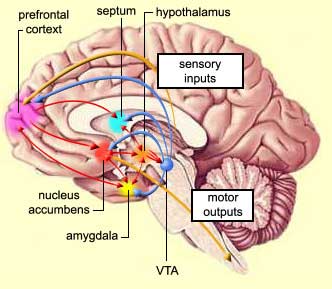Why Drugs Can Be Addicting
How does one go from liking drugs to needing them? The explanation lies in the brain’s intrinsic need to be in balance and its systems to correct imbalances in order to maintain harmony.
 Psychoactive drugs significantly overstimulate dopamine (by as much as ten times what natural rewards do1 and cause long-lasting changes in the brain’s Limbic “reward” system. This over-stimulation has a cost; it depletes dopamine pathways long after the last dose. For example, disruption of dopamine in the brain’s frontal cortical area (involved in motivation, drive and impulse) is evident as long as 100 days after cocaine use.2 Dr. Nora Volkow, a neuroscientist who studies addiction, is the researcher who demonstrated this long-lasting impact. She says, “The disruption of the dopamine pathways leads to a decrease in the reinforcing value of normal things, and this pushes the individual to take drugs to compensate.”3 This explains why addicts lose interest in things, activities and people they once loved during the slide into addiction.
Psychoactive drugs significantly overstimulate dopamine (by as much as ten times what natural rewards do1 and cause long-lasting changes in the brain’s Limbic “reward” system. This over-stimulation has a cost; it depletes dopamine pathways long after the last dose. For example, disruption of dopamine in the brain’s frontal cortical area (involved in motivation, drive and impulse) is evident as long as 100 days after cocaine use.2 Dr. Nora Volkow, a neuroscientist who studies addiction, is the researcher who demonstrated this long-lasting impact. She says, “The disruption of the dopamine pathways leads to a decrease in the reinforcing value of normal things, and this pushes the individual to take drugs to compensate.”3 This explains why addicts lose interest in things, activities and people they once loved during the slide into addiction.
If the brain encounters drug or alcohol-induced over-stimulation occasionally, it responds defensively to each as an individual event. That’s what hangovers are. (For more click on Hangover versus Withdrawal.) However, if the reward system is overstimulated regularly, over time it learns to anticipate the over-stimulation and primes defensive systems to respond with a much more powerful and long-lasting protective reaction.
One defensive response is to make the reward system less efficient. This is accomplished by reducing the number of receptors available for docking with dopamine, as if removing extra seats in a game of musical chairs while keeping the same number of players. Addiction researchers found, for example, that alcoholics’ brains contain fewer dopamine receptors than non-drinkers. Monkeys allowed to self-administer cocaine for a year had 15%-20% fewer dopamine receptors.4 Similarly, former methamphetamine abusers showed an average of 24% fewer dopamine transporters than non-users in the striatum, a part of the reward system.5
In other words, the brain’s defensive response to drug abuse causes physical and structural changes in receptor and neurotransmitter activity which significantly alters neural function. The repeated shocks of continuous and predictable drug abuse cause the brain to temporarily reprogram itself in defense.
Tolerance induces a reaction by the user, however. Since it dulls the high that drugs evoke, users take more: only by increasing the amount of dopamine through increasing the dose or frequency of drugs, or both, can the addict feel the same reward she used to feel before tolerance developed.6
Increasing drug use releases more dopamine, the users’ retaliation to the brain’s defense. But the brain doesn’t take the increased use lying down. It responds by making the system even less efficient. A vicious downward-spiraling cycle develops as the brain tries to counteract drug abuse by gumming up the reward system ever more, while the user compensates by taking more and more drugs. This prompts further brain change, which in turn elicits increased drug taking, accelerating the downward spiral. This process of deepening tolerance is a key reason addiction is a progressively-worsening disease.
Reducing the number of dopamine receptors significantly affects neurons’ ability to transmit and receive messages. As neurons go, so go their neural networks: “Ultimately, adaptations that drug exposure elicits in individual neurons alter the functioning of those neurons, which in turn alters the functioning of the neural circuits in which those neurons operate. This leads eventually to the complex behaviors…that characterize an addicted state.”7
Without the dopamine boost provided by drugs, abusers suffer a dopamine deficit, resulting in withdrawal and depression. “Eventually, the dopamine circuit becomes blunted; with tolerance, a drug simply pushes the circuit back to normal, boosting the user out of depression, but no longer propelling him or her toward euphoria.”8 The essence of the addict experience, neuroscientists say, is that they eventually have to take drugs to maintain an ever-harder-to-achieve “new normal” in which the brain, having developed tolerance, now requires them to maintain the “new normal.” It now needs drugs to stave off withdrawal, instead of just wanting them to get high.
A byproduct of increasing tolerance is worsening withdrawal, causing detoxes to become progressively longer and more severe — what users think of as a hangover (but what’s actually withdrawal) stretches from one to two days, then to three and four.9 The fear of withdrawal escalates as well, with good reason.
Long-term drug abuse can also the brain to adapt to what it perceives as a permanent change in its reward system, which can trigger genetic change. When this happens, the brain changes associated with tolerance can be inherited. For more click on Genetic and Environmental Components of Addiction).
The other articles in this series are:
- How Drugs Get You High
- How Tolerance Develops
- Differences In Addictions: Acute vs. Non-Acute Toxicity
- Why Relapse Is Common: “Triggers”
Click here to return to the Addiction Science Menu.
